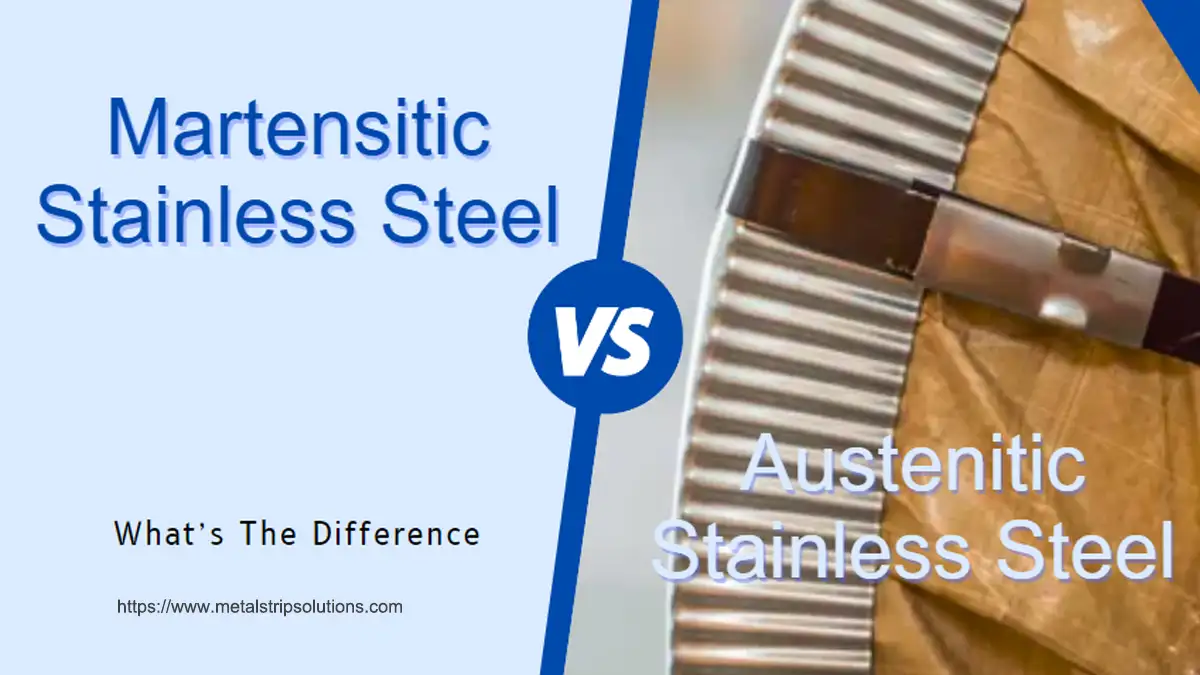Martensitic and austenitic are the two different phases of stainless steel and have different manufacturing methods and properties.
Austenitic stainless steel is also called a high-temperature phase. To achieve this phase, heat the ferrite to 912 °C.
At this point, stainless steel changes its structure from a body-centered cubic crystal structure to a face-centered cubic crystal structure. While martensitic crystal structure is obtained when heated, austenite structure is rapidly cooled by a quenching process, and a body-centered cubic structure is formed.
Compared to austenitic stainless steels, martensitic stainless steels are less chemical resistant, although they can still be heated and hardened.
When hardness is important, such as in knives where surface hardness produces a sharper blade, martensitic stainless steel is frequently utilized.
Austenitic stainless steel is non-magnetic and most widely used in kitchen equipment, food processing heat exchangers, etc.
In this article, we introduce the differences between martensitic and austenitic stainless steels.
If you are the engineers or the purchasers, this article is helpful.
Let’s keep reading.
What is Martensitic Stainless Steel?
The process of quenching involves rapidly cooling steel to produce an incredibly hard substance called martensitic.
It has good strength and very low ductility.
Martensite is perfect for applications needing resistance to wear or abrasion due to its high strength. Due to the presence of ferrite, it is also extremely magnetic and has great electrical conductivity.
When utilized in harsh conditions, martensitic must be coated or treated with lubricants since it is neither corrosion- nor oxidation-resistant.
Like with other stainless steel alloys, Martensitic stainless steel is mostly comprised of iron with a small amount of carbon and other alloys.
Martensitic stainless steel has about 1.2% of the carbon. The additional alloying components are nickel and chromium (between 11.5 and 18%).
Martensitic stainless steel is strong due to its high carbon content, but its corrosion resistance is reduced by the absence of a large amount of nickel.
What is Austenitic Stainless Steel?
Austenite is a non-magnetic type of stainless steel with a minimum chromium content of 16% and a minimum nickel content of 8%.
Due to this combination, Austenite has strong corrosion resistance, good formability, and weldability properties.
When compared to martensitic, Austenite also possesses greater creep resistance at high temperatures, high ductility, tensile strength, toughness, and other excellent mechanical qualities.
Due to its exceptional corrosion-resistant qualities, austenite is widely used for applications including chemical processing machinery and nuclear reactors.
Austenitic stainless steel has obtained its hardness by cold working; it cannot be hardened by heat treatment.
Due to outstanding corrosion resistance, austenitic stainless steels are frequently utilized, especially in stainless steel screws.
Difference between Martensitic and Austenitic stainless steel
Chemical composition is the main difference between martensitic and austenitic stainless steel, specially the concentration of carbon contents.
Austenite stainless steel has lower carbon content than the majority of martensitic stainless steel grades.
Additionally, the high carbon concentration decreases corrosion resistance while increasing hardness.
Therefore martensitic stainless steel has low corrosion and more hardness than Austenitic steel.
Composition
The chemical composition of the martensitic is shown in the given table:
AISI Grades | C % | Mn % | Si % | Cr % | Ni % | Mo % | P % | S % |
410 | 0.15 | 1.0 | 0.5 | 11.5-13.0 | – | – | 0.04 | 0.03 |
416 | 0.15 | 1.25 | 1.0 | 12.-14.0 | – | 0.60 | 0.04 | 0.15 |
420 | 0.150-0.40 | 1.0 | 1.0 | 12.0-14.0 | – | – | 0.04 | 0.03 |
431 | 0.2 | 1.0 | 1.0 | 15.0-17.0 | 2.0 | 1.25-2.00 | 0.04 | 0.03 |
440A | 0.6-0.75 | 1.0 | 1.0 | 16.0-18.0 | – | 0.750 | 0.04 | 0.03 |
440B | 0.75-0.95 | 1.0 | 1.0 | 16.0-18.0 | – | 0.750 | 0.04 | 0.03 |
440C | 0.95-1.20 | 1.0 | 1.0 | 16.0-18.0 | – | 0.750 | 0.04 | 0.03 |
416Se | 0.10 | 1.25 | 1.0 | 11.50-14.0 | – | – | 0.06 | 0.15 |
Given table shows the Chemical composition of Austenitic stainless steel:
AISI Grades | C % | Mn % | Si % | Cr % | Ni % | Mo % | P % | S % |
201 | 0.15 Max | 5.50-7.50 | 1 | 16.0-18.0 | 3.50-5.50 | – | 0.06 Max | 0.03 Max |
301 | 0.15 Max | 2.00 | 1 | 16.0-18.0 | 6.0-8.0 | – | 0.045 Max | 0.03 Max |
304 | 0.08 Max | 2.00 | 0.75 | 18.0-20.0 | 8.0-10.50 | – | 0.045 Max | 0.03 Max |
304L | 0.03 Max | 2.00 | 0.75 | 18.0-20.0 | 8.0-12.0 | – | 0.045 Max | 0.03 Max |
316 | 0.08 Max | 2.00 | 0.75 | 16.0-18.0 | 10.0-14.0 | 2.0-3.0 | 0.045 Max | 0.03 Max |
316L | 0.03 Max | 2.00 | 0.75 | 16.0-18.0 | 10.0-14.0 | 2.0-3.0 | 0.045 Max | 0.03 Max |
321 | 0.08 Max | 2.00 | 0.75 | 17.0-19.0 | 9.0-12.0 | – | 0.045 Max | 0.03 Max |
347 | 0.08 Max | 2.00 | 0.75 | 17.0-19.0 | 9.0-13.0 | – | 0.045 Max | 0.03 Max |
Properties
Properties of martensitic stainless steel
Weldibilty
This type of steel is not suitable for welding due the brittleness. However tempering process can decrease its brittleness and increase the applications of this grade.
Hardness
Martensitic stainless steel grade has excellent hardness due to high concentration of carbon than austenitic stainless steel.
High tensile strength
Martensitic Stainless steel reacts well to hardening and tempering because of its high carbon content. As a result, the tensile strength of this grade can be increased in comparison to other stainless steels grades.
Properties of Austenitic stainless steel
Corrosion resistance
This grade of stainless steel shows excellent resistance to corrosion, especially in situations with high chloride levels, acidic conditions, and alkaline.
Good high-temperature strength
Some grades of Austenitic stainless steel show excellent strength, stability, mechanical properties and creep resistance at very high temperatures.
Mechanical Behavior
Mechanical properties of martensitic stainless steel:
AISI Grades | Yield strength at 20 °C MPa | Specefic heat capacity J/(kg·K) at 20 °C | Tensile strength at 20 °C MPa | Elongation at 20 °C | Melting point at 20 °C | |
410 | 540 | 460 | 740 | 16% | 1480 °C | |
420 | 760 | 460 | 980 | 12% | 1450 °C | |
431 | 1070 | 460 | 1390 | 15% | 1450°C | |
440A | 1650 | 460 | 1790 | 5% | 1370°C | |
440B | 1860 | 430 | 1930 | 3% | 1370°C | |
440C | 1900 | 430 | 1970 | 2% | 1370°C | |
Mechanical properties of austenitic stainless steel:
AISI Grades | Yield strength at 20 °C MPa | Specefic heat capacity J/(kg·K) at 20 °C | Tensile strength at 20 °C MPa | Elongation at 20 °C | Melting point at 20 °C |
201 | 310 | 500 | 660 | 46% | 1375-1450 °C |
205 | 460 | 460 | 810 | 46% | 1375-1450 °C |
301L | 250 | 450 | 630 | 52% | 1375-1450 °C |
303 | 240 | 500 | 600 | 52% | 1400°C |
304L | 200 | 500 | 550 | 42% | 1400°C |
316 | 240 | 490 | 580 | 42% | 1380°C |
Cost
The cost of austenitic stainless steel is more than martensitic due to it has more nickel content in its composition.
Applications
Martensitic stainless steel applications:
There are many heat treatments and compositions for martensitic stainless steels. Due to its many characteristics, martensitic stainless steel can be utilized for a variety of purposes, such as:
- Medical equipment
- Rotating blades
- Bushing and Bearings
- Fasteners Micrometers and Valves
Austenitic stainless steel applications:
Austenitic stainless steels have a very wide range of applications in the more demanding end-use applications.
- Equipment for power generation and medical use
- Equipment for Chemical Processing
- Kitchen utensils and equipment
- Automotive and Aerospace Components
- Vessels and pipes for storage tanks
- Cutlery architecture
- Food and beverage equipment
Conclusion
Overall, martensitic stainless steel and austenitic stainless steel have a very wide range of applications and are mostly used to fulfill industrial and household requirements.
They both have different mechanical and physical properties.
You can easily choose your desired grade of stainless steel strips according to our application needs. We have expertise in all grades of stainless steel and alloys.
If you want to discuss any problem regarding your project, feel free to contact us.












